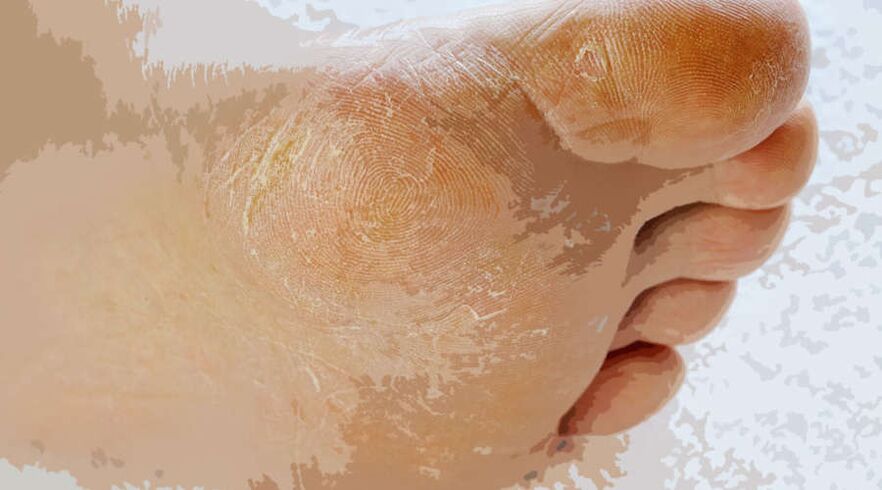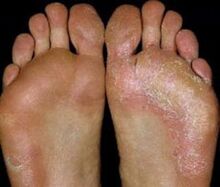
Foot mycosis (ICD code 10 B35. 3) is a fungal infection of the skin on the legs caused by parasitic dermatophytes. It occurs in about 20% of adults. Infection occurs through microtrauma, scratches, abrasions, wounds. The disease develops with wet feet, diabetes and weak immunity.
The prevalence rate among people with endocrine diseases and immunodeficiency reaches 50%. More often, the disease persists in a chronic form with variable remission and exacerbation. In 40-50% of cases, mycosis of the feet causes onychomycosis or fungal infection of the nails.
Where and why does the infection occur?
Foot mycosis is a contagious disease that can be easily transmitted by direct contact with a fungal carrier or household items. For example, through shoes, socks, towels, manicure accessories, rubber mats in the shower. In 70-95% of cases, the causative agent of foot mycosis is Trichophyton red (Tr. Rubrum).
Infection usually occurs in public places with high humidity and favorable conditions for the growth and spread of the pathogen. These areas include swimming pools, public showers, saunas, water parks, gym locker rooms. If a person infected with a fungus walks barefoot or in the shower, it leaves the infectious particles behind. And then if a healthy person steps on it with bare feet, the pathogen will fall on the skin. In this case, the fungus does not always manifest itself immediately and causes the characteristic symptoms of the disease. With strong immunity and no health problems, a person not only remains a carrier of the infection, but also does not get sick.
Increased risks of fungal infections and the development of mycosis of the feet:
- damage to the integrity of the skin;
- impaired blood supply to the extremities, which worsens the supply of oxygen and nutrients to the tissues, slows down the regeneration process, weakens the local immunity;
- diabetes, high glucose levels create favorable conditions for the growth of the fungus, the development of infection;
- excessive sweating;
- dry skin, which causes micro-cracks;
- old age;
- blood diseases;
- long-term use of antibiotics, drugs that suppress immunity;
- vitamin deficiency;
- Wear shoes that are airtight and create a "greenhouse effect".
Symptoms and types of the disease

Foot mycoses manifest themselves in different ways, the type of pathogen and the severity of the lesion affect the symptoms. . The first signs of the disease appear in the wrinkles between the fingers and from there spread to the plantar, lateral, posterior sides and nails.
The photo shows how the feet look with mycosis.
When nails are infected, thickening, loss of shine, nausea are noted. The nail takes on a yellow, gray color, becomes brittle and falls apart.
Early clinical symptoms of mycosis of the feet include dryness, peeling of the skin, painless cracks in the wrinkles between the toes. This form of the disease is called deletion. Initially, peeling and cracks do not cause pain, itching and discomfort. Only a doctor can see the first unexplained signs of a fungal infection. In addition to the deleted one, other clinical forms of foot mycosis also differ, each with its own symptoms.
Squamous
Foot mycosis is squamous, with wrinkles between and on the toes. As a rule, there are no signs of inflammation. Redness of the skin, damage to the nails, itching, thickening of the stratum corneum are possible. Papillary lines become clearer and the surface of the skin is covered with lamellar scales, dry. In this case, the patient does not feel itching or other unpleasant sensations.
Hyperkeratotic
looks like a rash on vaults. The surface of the elements of the spill is covered with gray-white layered scales. Part of the epidermis, there are single vesicles. When the debris joins together, it forms indeterminate large seals that extend along the heel, including the lateral and dorsal surfaces. In addition to the foci of peeling, there are areas of hyperkeratosis or thickening of the skin. They look like calluses with cracks on them. The area affected by a hyperkeratotic foot mycosis resembles the manifestations of psoriasis or eczema. A person is worried about dryness, itching and sometimes pain.
Intertriginous
The intertriginous form of foot microsis is similar to the symptoms of a uterine rash. Thus latdan name. intertrigo - "diaper rash". More often the skin is affected by the gaps between the third and fourth, fourth and fifth fingers. Bright red, edematous. Weeping wounds, deep, painful cracks appear. Unlike diaper rash, lesions in intertriginous mycosis are rounded with clear contours that separate a white outline along the edges of the epidermis. The person feels itching, burning, pain.
Dyshidrotic
Dyshidrotic forms of mycosis of the feet are characterized by numerous vesicles with thick tops, located mainly in the arches. The rash spreads to large areas of the toes, as well as to the spaces between the toes and the skin. Combine to create large bubbles. Wet erosion appears instead of an exploding balloon. As the inflammation progresses, the skin becomes red and swollen. During the formation of vesicles, the patient feels an unbearable itching.
Diagnosis
If you suspect foot mycosis, you should consult a dermatologist. To confirm the diagnosis, the doctor will examine the feet, ask the person what symptoms are bothering him, how long before and after. Microscopic analysis, take a fragment from the affected area for cultural research to identify a specific type of pathogen. In addition, your doctor may order blood tests.
How to treat mycosis of the feet?
A mycologist or dermatologist treats mycosis of the skin of the feet. Depending on the clinical form of the disease, the severity of the lesion, the visible changes, the doctor will choose an adequate therapy.
Complications of mycotic infection in the legs can lead to fungal infections of the hands. Mycosis of the feet sometimes causes secondary bacterial infections, especially when there are weeping sores on the skin.
External fungicides (ointments, creams), tablets for oral administration are prescribed to combat the fungus. Only topical therapy is effective for milder forms of mycosis of the feet. In severe cases, oral medications are prescribed according to clinical guidelines.
If necessary, treatment is supplemented with anti-inflammatory, drying, antiseptic, anti-allergic drugs that increase the regeneration of damaged tissues. If there are signs of a bacterial infection, antibiotic therapy is prescribed.
Areas infected with onychomycosis are cleaned with a machine. Local antifungal agents are prescribed for further treatment of nails: varnish, cream or ointment.
The duration of treatment is from two weeks to one month. If not only the skin but also the nails are affected, treatment is delayed. This is due to the slow growth of the nail. To get rid of the infection, a completely healthy nail plate needs to grow again.
Mycosis can be successfully treated if the doctor's instructions are followed. However, if a patient who sees an improvement stops taking the medication, it causes the infection to return and become chronic. Although the symptoms of the disease have already disappeared, it is necessary to complete the full course.
It is very important in the treatment of foot mycosis foot care, personal hygiene, diet, the choice of comfortable shoes that do not harm the affected areas.
What to do to prevent it?
The following tips will help to prevent or reduce the risk of developing mycoses of the feet and nails:
- Controls chronic diseases of the lower circulatory system. extremities are damaged or the body's defenses are reduced;
- Wash your feet daily with soap and water, then dry with a towel, especially wrinkles between the toes;
- ventilate your shoes and change socks daily;
- Wear indoor rubber slippers when coming to public showers, saunas, swimming pools, baths;
- In case of excessive sweating, use antiperspirant for feet, disinfectant for shoes, do not wear other people's shoes, socks, tights;
- Do not use someone else's towel or clothes.
If you notice a slight peeling of the skin on your feet or cracks between your toes, it is worth taking a fungal test. Early diagnosis and timely treatment will help prevent complications, extensive damage, discomfort, pain while walking, and bacterial infection.





























